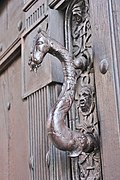
A door knocker is an item of door furniture that allows people outside a house or other dwelling or building to alert those inside to their presence. A door knocker has a part fixed to the door, and a part (usually metal) which is attached to the door by a hinge, and may be lifted and used to strike a plate fitted to the door, or the door itself, making a noise. The struck plate, if present, would be supplied and fitted with the knocker. Door knockers are often ornate, but may be no more than a simple fitting with a metal bob, or ring.














